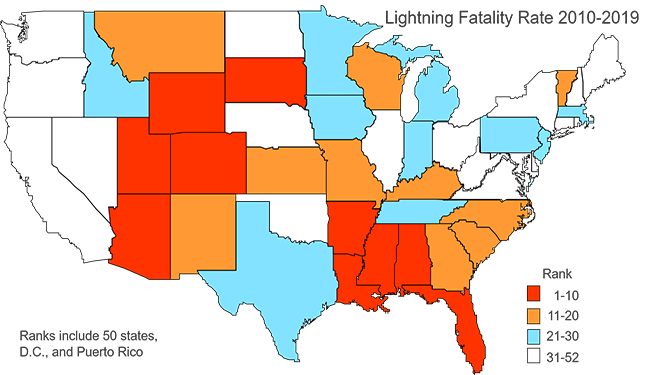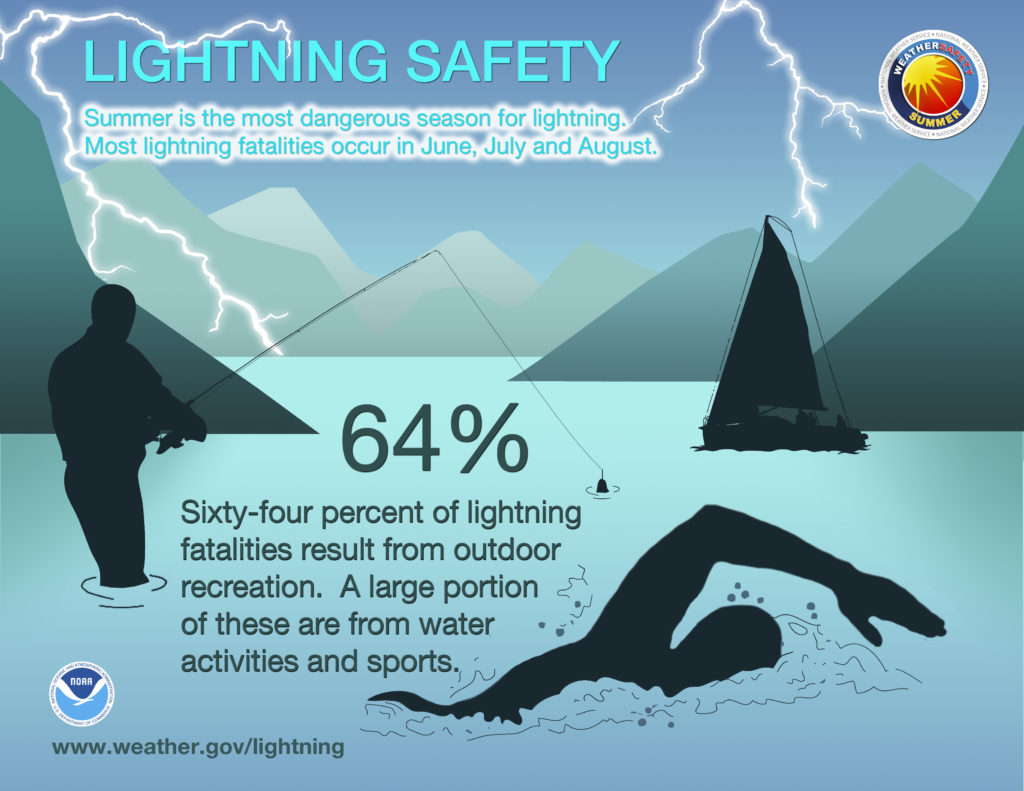Severe Weather 101: Lightning Safety

Lightning strikes the United States about 25 million times a year. Although most lightning occurs in the summer, people can be struck at any time of year. Lightning kills 20 or more people in the United States each year, and hundreds more are severely injured.
Lightning Safety
There is no safe place outside when thunderstorms are in the area. If you hear thunder, you are likely within striking distance of the storm. Just remember, When Thunder Roars, Go Indoors. Too many people wait far too long to get to a safe place when thunderstorms approach. Unfortunately, these delayed actions lead to many of the lightning deaths and injuries in the United States.
Lightning Safety Outdoors
There is little you can do to substantially reduce your risk if you are outside in a thunderstorm. The only completely safe action is to get inside a safe building or vehicle.
If you absolutely cannot get to safety, you can slightly lessen the threat of being struck with the following tips. But don’t kid yourself–you are NOT safe outside. Know the weather patterns of the area you plan to visit. For example, in mountainous areas, thunderstorms typically develop in the early afternoon, so plan to hike early in the day and be down the mountain by noon. Listen to the weather forecast for the outdoor area you plan to visit. The forecast may be very different from the one near your home. If there is a high chance of thunderstorms, stay inside.
- Avoid open fields, the top of a hill or a ridge top.
- Stay away from tall, isolated trees or other tall objects. If you are in a forest, stay near a lower stand of trees.
- If you are in a group, spread out to avoid the current traveling between group members.
- If you are camping in an open area, set up camp in a valley, ravine or other low area. Remember, a tent offers NO protection from lighting.
- Stay away from water, wet items, such as ropes, and metal objects, such as fences and poles. Water and metal do not attract lightning but they are excellent conductors of electricity. The current from a lightning flash will easily travel for long distances.

Lightning Safety Indoors
Safe shelters are buildings with electricity and plumbing or metal-topped vehicles with the windows closed. Picnic shelters, dugouts and small buildings without plumbing or electricity are not safe. Below are some key safety tips for you, your pets and your home. There are three main ways lightning enters structures: a direct strike, through wires or pipes that extend outside the structure or through the ground. Once in a structure, lightning can travel through the electrical, phone, plumbing, and radio/television reception systems. Lightning can also travel through any metal wires or bars in concrete walls or flooring..
- Stay off corded phones. You can use cellular or cordless phones.
- Don’t touch electrical equipment such as computers, TVs, or cords. You can use remote controls safety.
- Avoid plumbing. Do not wash your hands, take a shower or wash dishes.
- Stay away from exterior windows and doors doors that might contain metal components leading from outside your home to the inside.
- Stay off balconies, porches and out of open garages or car ports.
- Do not lie on concrete floors or lean against concrete walls.
- Protect your pets: Dog houses are not safe shelters. Dogs that are chained to trees or on metal runners are particularly vulnerable to lightning strikes.
- Protect your property: Lightning generates electric surges that can damage electronic equipment some distance from the actual strike. Typical surge protectors will not protect equipment from a lightning strike. Do not unplug equipment during a thunderstorm as there is a risk you could be struck.
How Does Lightning Form?
Lightning is a giant spark of electricity in the atmosphere or between the atmosphere and the ground. In the initial stages of development, air acts as an insulator between the positive and negative charges in the cloud and between the cloud and the ground; however, when the differences in charges becomes too great, this insulating capacity of the air breaks down and there is a rapid discharge of electricity that we know as lightning.
What if You Are Struck By Lightning?
Cardiac arrest is the immediate cause of death for those who die. Lightning victims do not carry an electrical charge and may need first aid immediately. If someone is struck by lightning, call 9-1-1- immediately. Then give first aid by performing CPR if you are trained. Use an Automatic External Defibrillator if one is available. These units are lifesavers!
Lightning Facts
Did you know that lightning often strikes outside of the area of heavy rain and may strike as far as 10 miles from any rainfall? Many lightning deaths occur ahead of storms before any rain arrives or after storms have seemingly passed and the rain has ended.
If you can hear thunder, you are in danger. Don’t be fooled by the blue skies. If you hear thunder, lightning is close enough to pose an immediate threat.
Lightning leaves many victims with permanent disabilities. While only 10% of lightning victims die, many survivors must live the rest of their lives with intense pain, neurological disabilities, depression, and other health problems.
For more information about lightning, visit www.weather.gov/lightning